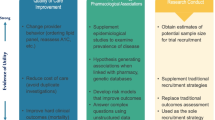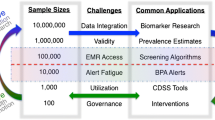Abstract
Improving quality of care through the enhanced use of digital technologies is becoming an increasingly primary focus of the health care industry in general and cardiovascular (CV) medicine in particular. The recent rapid adoption of electronic health records (EHR) has the potential to improve the management of CV disease by removing variability and assuring at least consideration of guideline-recommended care and appropriate use criteria. This can lead to improved cardiac outcomes at all phases of care; beginning with the automated identification of patients who are at increased risk, implementing evidence based medicine for primary CV prevention, using online decision support tools for acute management, and, possibly most importantly, by connecting the health care provider and the patient through open accessibility to their EHR. The widespread use of EHR is the dawn of a new era where evidence based guidelines can be seamlessly translated to patient care and where patients are actively involved in their own health. As transformative as this will be, it is important to recognize that we are currently experiencing only the very earliest potential of the EHR in improving CV outcomes.
Similar content being viewed by others
References
Papers of particular interest, published recently, have been highlighted as: • Of importance •• Of major importance
Buntin MB, Burke MF, Hoaglin MC, Blumenthal D. The benefits of health information technology: A review of the recent literature shows predominantly positive results. Health Aff. 2011;30(3):464–71. This review of literature showed measurable benefits from the adoption of health information technology in improving quality of care and outcomes..
Blumenthal D, Glaser JP. Information technology comes to medicine. N Engl J Med. 2007;356(24):2527–34.
Bates DW, Leape LL, Cullen DJ, Laird N, Petersen LA, Teich JM, et al. Effect of computerized physician order entry and a team intervention on prevention of serious medication errors. JAMA. 1998;280(15):1311–6.
Spertus JA, Eagle KA, Krumholz HM, Mitchell KR, Normand SL. American College of Cardiology/American Heart Association Task Force on Performance Measures. American college of cardiology and american heart association methodology for the selection and creation of performance measures for quantifying the quality of cardiovascular care. J Am Coll Cardiol. 2005;45(7):1147–56.
Heidenreich PA, Trogdon JG, Khavjou OA, Butler J, Dracup K, Ezekowitz MD, et al. American Heart Association Advocacy Coordinating Committee. Stroke Council. Council on Cardiovascular Radiology and Intervention. Council on Clinical Cardiology. Council on Epidemiology and Prevention. Council on Arteriosclerosis. Thrombosis and Vascular Biology. Council on Cardiopulmonary. Critical Care. Perioperative and Resuscitation. Council on Cardiovascular Nursing. Council on the Kidney in Cardiovascular Disease. Council on Cardiovascular Surgery and Anesthesia, and Interdisciplinary Council on Quality of Care and Outcomes Research. Forecasting the future of cardiovascular disease in the united states: A policy statement from the american heart association. Circulation. 2011;123(8):933–44.
Steinhubl SR, Bloom Jr FJ, Darer J. Being successful at prevention: Making it easy to do the right thing: Comment on "improving care after myocardial infarction using a 2-year internet-delivered intervention". Arch Intern Med. 2011;171(21):1917–9.
Kennedy EH, Wiitala WL, Hayward RA, Sussman JB. Improved cardiovascular risk prediction using nonparametric regression and electronic health record data. Med Care. 2013;51(3):251–8. This study showed that the use of EHR-derived models can substantially improve risk prediction for CV disease..
Chaudhry B, Wang J, Wu S, Maglione M, Mojica W, Roth E, et al. Systematic review: Impact of health information technology on quality, efficiency, and costs of medical care. Ann Intern Med. 2006;144(10):742–52.
Persell SD, Dunne AP, Lloyd-Jones DM, Baker DW. Electronic health record-based cardiac risk assessment and identification of unmet preventive needs. Med Care. 2009;47(4):418–24.
Hillestad R, Bigelow J, Bower A, Girosi F, Meili R, Scoville R, et al. Can electronic medical record systems transform health care? potential health benefits, savings, and costs. Health Aff. 2005;24(5):1103–17.
Hivert MF, Dusseault-Belanger F, Cohen A, Courteau J, Vanasse A. Modified metabolic syndrome criteria for identification of patients at risk of developing diabetes and coronary heart diseases: Longitudinal assessment via electronic health records. Can J Cardiol. 2012;28(6):744–9.
Hivert MF, Grant RW, Shrader P, Meigs JB. Identifying primary care patients at risk for future diabetes and cardiovascular disease using electronic health records. BMC Health Serv Res. 2009;9:170.
McGlynn EA, Asch SM, Adams J, Keesey J, Hicks J, DeCristofaro A, et al. The quality of health care delivered to adults in the united states. N Engl J Med. 2003;348(26):2635–45.
Lester WT, Grant RW, Barnett GO, Chueh HC. Randomized controlled trial of an informatics-based intervention to increase statin prescription for secondary prevention of coronary disease. J Gen Intern Med. 2006;21(1):22–9.
Samal L, Linder JA, Lipsitz SR, Hicks LS. Electronic health records, clinical decision support, and blood pressure control. Am J Manag Care. 2011;17(9):626–32.
Pope JH, Ruthazer R, Beshansky JR, Griffith JL, Selker HP. Clinical features of emergency department patients presenting with symptoms suggestive of acute cardiac ischemia: A multicenter study. J Thromb Thrombolysis. 1998;6(1):63–74.
DeBusk RF, Miller NH, Raby L. Technical feasibility of an online decision support system for acute coronary syndromes. Circulation. Cardiovasc Qual Outcome. 2010;3(6):694–700. This study showed that computerized decision support tools are reliable in identifying low-risk patients and they should be used to achieve cost-effective care..
Peterson ED, Roe MT, Mulgund J, DeLong ER, Lytle BL, Brindis RG, et al. Association between hospital process performance and outcomes among patients with acute coronary syndromes. JAMA. 2006;295(16):1912–20.
Glickman SW, Boulding W, Staelin R, Mulgund J, Roe MT, Lytle BL, et al. A framework for quality improvement: An analysis of factors responsible for improvement at hospitals participating in the can rapid risk stratification of unstable angina patients suppress adverse outcomes with early implementation of the ACC/AHA guidelines (CRUSADE) quality improvement initiative. Am Heart J. 2007;154(6):1206–20.
Dunlay SM, Alexander KP, Melloni C, Kraschnewski JL, Liang L, Gibler WB, et al. Medical records and quality of care in acute coronary syndromes: Results from CRUSADE. Arch Intern Med. 2008;168(15):1692–8.
Byrd JB, Vigen R, Plomondon ME, Rumsfeld JS, Box TL, Fihn SD, et al. Data quality of an electronic health record tool to support VA cardiac catheterization laboratory quality improvement: The VA clinical assessment, reporting, and tracking system for cath labs (CART) program. Am Heart J. 2013;165(3):434–40.
Singh H, Spitzmueller C, Petersen NJ, Sawhney MK, Sittig DF. Information overload and missed test results in electronic health record-based settings. JAMA Intern Med. 2013;173(8):702–4. This survey showed that primary care physicians using EHR are vulnerable to information overload..
Walsh MN, Yancy CW, Albert NM, Curtis AB, Stough WG, Gheorghiade M, Heywood JT, McBride ML, Mehra MR, O'Connor CM, Reynolds D, Fonarow GC. Electronic health records and quality of care for heart failure. Am Heart J .
Persell SD, Wright JM, Thompson JA, Kmetik KS, Baker DW. Assessing the validity of national quality measures for coronary artery disease using an electronic health record. Arch Intern Med. 2006 Nov 13;166(20):2272–7. 25. Delbanco T, Walker J, Darer JD, Elmore JG, Feldman HJ, Leveille SG, Ralston JD, Ross SE, Vodicka E, Weber VD. Open notes: Doctors and patients signing on. Ann Intern Med. 2010;153(2):121–5.
Walker J, Leveille SG, Ngo L, Vodicka E, Darer JD, Dhanireddy S, et al. Inviting patients to read their doctors' notes: Patients and doctors look ahead: Patient and physician surveys. Ann Intern Med. 2011;155(12):811–9. This survey explored patients and physicians' attitudes toward potential benefits or harms if PCPs offered patients access to their visit notes..
Palen TE, Ross C, Powers JD, Xu S. Association of online patient access to clinicians and medical records with use of clinical services. JAMA. 2012;308(19):2012–9.
Yoo S, Kim S, Lee S, Lee KH, Baek RM, Hwang H. A study of user requests regarding the fully electronic health record system at seoul national university bundang hospital: Challenges for future electronic health record systems. Int J Med Inform. 2013;82(5):387–97.
McConnell KJ, Lindrooth RC, Wholey DR, Maddox TM, Bloom N. Management practices and the quality of care in cardiac units. JAMA Intern Med. 2013;173(8):684–92.
Battaglia L, Aronson MD, Neeman N, Chang JD. A "smart" heart failure sheet: Using electronic medical records to guide clinical decision making. Am J Med. 2011;124(2):118–20.
Compliance with Ethics Guidelines
Conflict of Interest
Mazen Roumia and Steven Steinhubl declare that they have no conflict of interest.
Human and Animal Rights and Informed Consent
This article does not contain any studies with human or animal subjects performed by any of the authors.
Author information
Authors and Affiliations
Corresponding author
Additional information
This article is part of Topical Collection on Ischemic Heart Disease
Rights and permissions
About this article
Cite this article
Roumia, M., Steinhubl, S. Improving Cardiovascular Outcomes Using Electronic Health Records. Curr Cardiol Rep 16, 451 (2014). https://doi.org/10.1007/s11886-013-0451-6
Published:
DOI: https://doi.org/10.1007/s11886-013-0451-6




